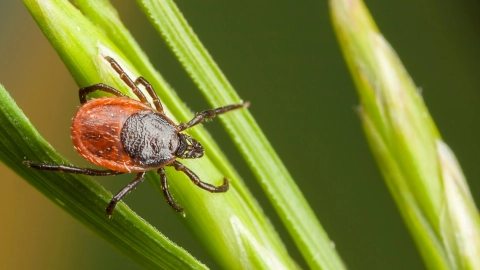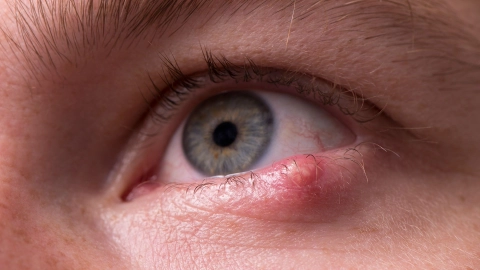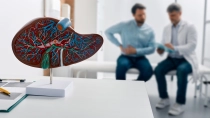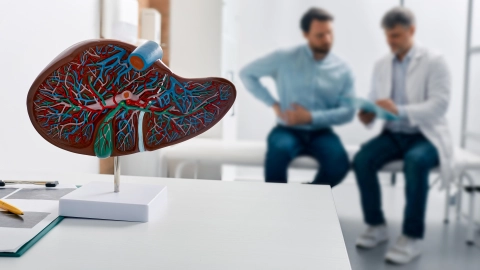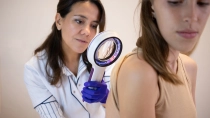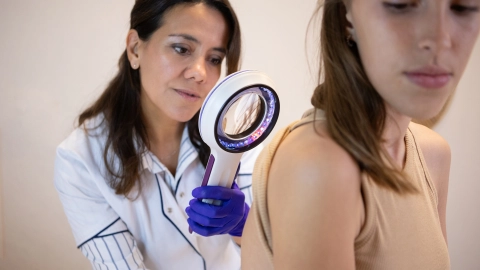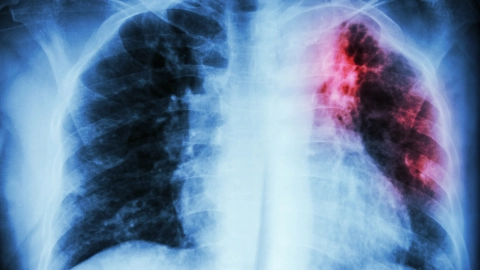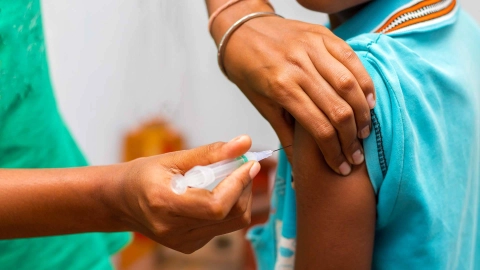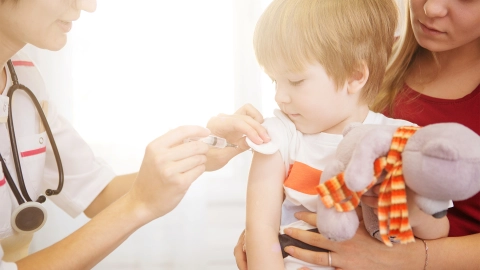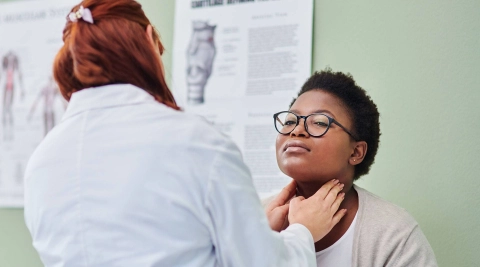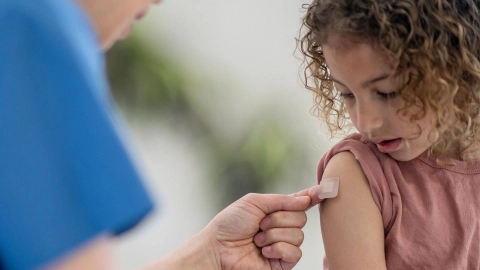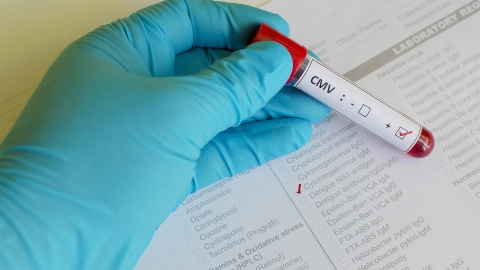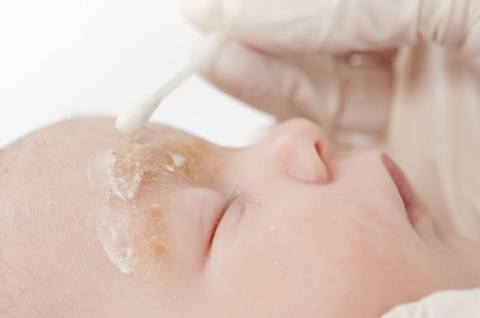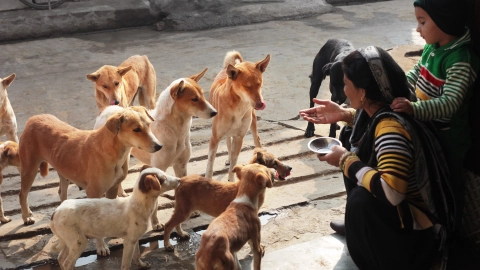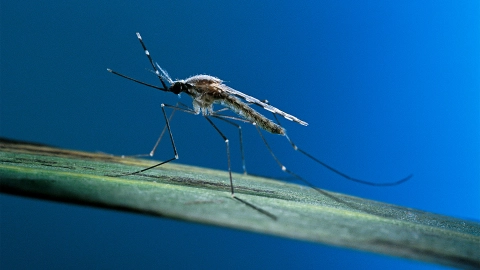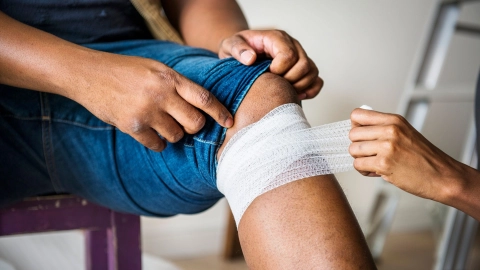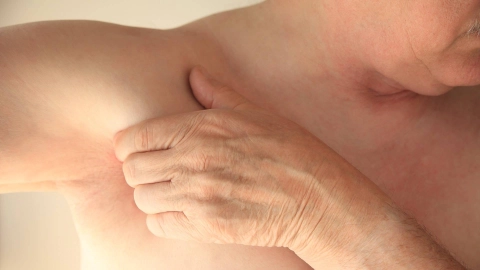Typical symptoms of acute gastritis are stomachache, feeling full, bloating, gas and heartburn. In most cases, gastritis is caused by a bacterial infection or the use of certain pain medication.
Find out more
Shingles (herpes zoster) is a painful viral skin condition. The viruses attack nerves and cause an inflammation that spreads over the skin.
Find out more
Symptoms of an infection with noroviruses are vomiting and diarrhea. An outbreak of this illness must be halted quickly.
Find out more
Roseola is a childhood illness involving a high temperature followed by a rash. The viral infection is usually harmless.
Find out more
The HIV virus infects immune cells and weakens the immune system. The serious illnesses caused by HIV are collectively known as AIDS.
Find out more
Chlamydia are bacteria that cause sexually transmitted diseases that frequently go unnoticed.
Find out more
Someone who suffers from sinusitis has, for example, a blocked nose and a feeling of pressure in the forehead or jaw.
Find out more
Scabies develops as a result of a mite infestation in the skin. Severe itching is typical. Scabies is contagious with extended skin contact. However, the disease can be treated.
Find out more
With acute bronchitis, the lower airways (bronchi) become temporarily inflamed. Initially, there is a dry cough but phlegm may later be coughed up from the airways.
Find out more
Women are most likely to get urinary tract infections. Cystitis is a bacterial infection of the bladder that can usually be treated effectively. A burning pain when passing urine is typical.
Find out more
Middle ear infections are one of the most common illnesses among small children. Children with an infection cry often and complain of pain.
Find out more
Athlete’s foot (tinea pedis) can redden or crack the skin and cause itchiness. It can usually be effectively treated with creams. Keeping the feet dry is important with athlete’s foot.
Find out more
Tick-borne encephalitis (TBE) is a viral infection transmitted by ticks. Vaccination offers protection against TBE.
Find out more
Most people experience warts at some stage of their lives. Warts are contagious and often very difficult to get rid of. Children and adolescents are at the highest risk of developing warts.
Find out more
Long COVID refers to health issues that persist or occur weeks or months after an acute COVID-19 infection. Fatigue and loss of stamina are common symptoms.
Find out more
COVID-19 is caused by an infection with SARS‑CoV‑2. The disease may be mild or very severe. Vaccinations and medication help prevent people from developing a severe form.
Find out more
Dengue fever is a viral disease transmitted by mosquitoes. Effective protection against mosquitoes is important to prevent infection when traveling to regions at risk for dengue fever.
Find out more
Styes and chalazia: what is eyelid inflammation and how does it progress? Learn more about the symptoms, causes, and treatment.
Find out more
Acute tonsillitis is accompanied by a sore throat and fever. Recurring tonsillitis in short intervals can be very difficult to endure.
Find out more
Typical signs of conjunctivitis are eyelids that stick together and an itching and burning sensation in the eyes. It can be caused by viruses or bacteria, but can also have other causes.
Find out more
Molluscum contagiosum is a virus causing small, wart-like papules (spots). It is a viral infection of the skin that mainly affects children.
Find out more
Pneumonia typically brings on a sudden high fever, coughing and breathlessness. People without any pre-existing conditions normally recover after a few weeks.
Find out more
Sepsis, also known as blood poisoning, is an uncontrolled inflammatory reaction of the body to infections. It needs to be treated very quickly in hospital.
Find out more
Boils (furuncles), carbuncles, abscesses and pimples are all linked to inflamed skin but differ slightly from one another. Medical treatment is often useful for boils.
Find out more
Yellow fever is a tropical disease caused by a virus that occurs in Africa and South America. It is transmitted by mosquitoes. Travelers can protect themselves by getting a vaccine.
Find out more
West Nile fever is a viral infection transmitted by mosquitoes. It primarily occurs in warmer countries, but now also in Germany.
Find out more
Zika virus is mainly found in tropical countries. While it produces a mild infection, it can cause serious birth defects if it occurs during pregnancy.
Find out more
Hepatitis C is a viral infection of the liver transmitted through blood and, over time, can lead to severe liver damage. But these days this can almost always be avoided with medication.
Find out more
Genital herpes is one of the most common sexually transmitted infections (STI). It is triggered by herpes simplex viruses. The risk of becoming infected can be reduced through certain measures.
Find out more
With oral herpes, particular herpes viruses cause painful blisters known as cold sores to form. The condition heals on its own in 1 to 2 weeks. No treatment is normally required.
Find out more
Most infections with the EHEC bacteria come from contaminated food or traces of animal feces. EHEC can cause watery and bloody diarrhea and in some cases acute kidney failure.
Find out more
The skin rash that typically occurs with ringworm (tinea corporis) has a ring-like appearance. It usually clears up quickly if treated with an anti-fungal skin cream.
Find out more
MERS is a viral infection of the respiratory tract, which occurs predominantly on the Arabian Peninsula. The virus is mainly transmitted from dromedary camels to humans.
Find out more
SARS is an infectious disease of the lungs, which is caused by the SARS-CoV coronavirus. The virus first appeared at the end of 2002 and spread to more than 30 countries until the middle of 2003.
Find out more
Tuberculosis (TB) is a bacterial infectious disease most commonly affecting the lungs. It is relatively rare in Germany.
Find out more
Pubic lice are transmitted by physical proximity, particularly through sexual contact. Their bites cause bad itching in hirsute parts of the body. Here you can read what can be done about them.
Find out more
Campylobacter infection is an infectious disease with a high temperature and diarrhea. It is generally caused by eating contaminated food of animal origin.
Find out more
Salmonellosis is an infection caused by bacteria in food. The main symptom is diarrhea. It may be accompanied by abdominal pain, nausea and vomiting.
Find out more
Inflammation of the heart muscle (myocarditis) can occur after a viral infection, for example. The condition is often mild but can be fatal.
Find out more
Endocarditis is an inflammation of the inner lining of the heart (the endocardium). Early treatment is important to avoid complications.
Find out more
Inflammation of the epiglottis is usually caused by bacteria. Immediate treatment is required, as it can cause acute respiratory (breathing) distress.
Find out more
Pinworm infection is one of the most common human worm conditions. It is usually harmless, and it typically becomes apparent due to itching around the anus.
Find out more
Fifth disease is one of the most common viral illnesses in children. Most adults are immune to it. Pregnant women who do not have immunity can pass the virus on to their unborn child.
Find out more
A throat infection (pharyngitis) is usually caused by viruses. However, it can also be caused by bacteria, such as Streptococcus bacteria. This is known as streptococcal pharyngitis (strep throat).
Find out more
Syphilis is an infectious disease that is found worldwide. It is caused by the bacterium Treponema pallidum, which is primarily contracted through sexual intercourse.
Find out more
Gonorrhea is a sexually transmitted infection. It is common worldwide and is caused by gonococci bacteria (Neisseria gonorrhoeae).
Find out more
Hepatitis B is a viral infection of the liver transmitted during unprotected sex, for example. Find out how the infection goes on to develop, what complications it has and who should be vaccinated.
Find out more
Hepatitis A is an infectious disease often brought back from traveling. The main symptom is liver inflammation. Find out more about symptoms, treatment, and vaccine protection.
Find out more
Swine flu is a type of flu in pigs. On exceptions, it can be transmitted to humans. The 2009 flu pandemic is also referred to colloquially as the swine flu pandemic.
Find out more
Bird flu (avian influenza) primarily affects birds. It can also be transmitted to humans and other mammals. Infection is rare but often has severe symptoms.
Find out more
Clostridioides (Clostridium) difficile bacteria can cause intestinal inflammation and diarrhea. The condition is usually triggered by taking antibiotics.
Find out more
Encephalitis is an inflammation of the brain. It can have several causes, the most frequent being viruses.
Find out more
False croup is a condition of the airways. It usually occurs in small children. Typical symptoms include a barking cough, a rasping sound when breathing in, and a slight shortness of breath.
Find out more
Listeriosis is a bacterial infection caused by consuming contaminated food. Most cases are mild. However, some people may become seriously ill and can even die from listeriosis.
Find out more
Anthrax is a rare disease. It is transmitted from animals to humans. Certain occupational groups are at an increased risk of contracting the disease. Read more about symptoms, causes, and treatment.
Find out more
Leprosy is a bacterial infectious disease that primarily occurs in South East Asia, South America, and Africa. Though leprosy is curable, there are still serious outcomes.
Find out more
Polio (poliomyelitis) can cause permanent paralysis. Polio viruses have been almost eradicated thanks to large-scale vaccination campaigns. Unvaccinated children and adults can contract polio.
Find out more
Measles is a viral infection that causes fever and a skin rash. Serious complications can also occur. Vaccination offers protection against infection.
Find out more
Glandular fever is an infectious disease that is triggered by certain herpes viruses. It is usually transmitted in saliva. Hygiene measures are essential to prevention.
Find out more
Meningitis is an inflammation of the meninges (brain membranes). This can have multiple causes. If triggered by bacteria, meningitis can quickly become life-threatening.
Find out more
Many people confuse the flu with the common cold. Despite having similar symptoms, these two infections may develop differently. Flu begins suddenly, causing the sufferer to quickly feel very unwell.
Find out more
The first signs of a common colds are often sneezing and a sore throat. If rhinitis has fully kicked in, many people feel weak and ill.
Find out more
Mumps is a viral infection that typically causes swelling of the parotid glands. It can affect both children and adults. Vaccination protects against the disease.
Find out more
Toxoplasmosis is caused by the parasite Toxoplasma gondii. A third of all people are carriers, but only around 5% of them show symptoms of the disease.
Find out more
Fungal infections of the vagina occur frequently in women of childbearing age. They often require only brief treatment with vaginal suppositories or creams.
Find out more
Legionnaires’ disease is a respiratory disease caused by bacteria. It may or may not be accompanied by pneumonia. Infection results from water systems contaminated with Legionella bacteria.
Find out more
Cytomegalovirus infections (CMV) can be dangerous for unborn and premature babies and people with an immune deficiency.
Find out more
Whooping cough is a highly contagious disease triggered by bacteria. The disease can put severe stress on the body and lasts a long time.
Find out more
Scarlet fever bacteria (streptococci) cause an illness in children with symptoms such as a high temperature, sore throat, and a distinctive skin rash.
Find out more
If a person’s mouth constantly feels furry, it may be caused by oral thrush. It is rarely dangerous, but often unpleasant.
Find out more
Hantaviruses cause a flu-like illness with fever. The kidneys are often also affected. Rodents such as rats and mice and their excretions are carriers of the virus.
Find out more
Erysipelas and cellulitis are caused by bacteria that break through the skin barrier due to an injury. With prompt treatment, a complete recovery is usually possible.
Find out more
Typical signs of chickenpox are an extremely itchy skin rash with red blisters and a slight fever. This viral infection most frequently affects children between the ages of 2 and 10.
Find out more
Botulism is a rare type of poisoning caused by the bacterial botulinum toxin. Frequent sources of poisoning include canned and preserved foods. All suspected cases must be treated in hospital.
Find out more
Tetanus is triggered by certain bacteria. Even a small wound can be the portal of entry for the pathogen. Vaccination offers protection.
Find out more
Impetigo (impetigo contagiosa) is an itchy and sometimes painful infection of the skin. It is especially common in young children.
Find out more
Seborrheic dermatitis is a non-contagious inflammation of the skin. It causes red patches and oily flakes to form on the skin, especially on the face and scalp. Men are more often affected than women.
Find out more
Diarrhea is a common illness. It is often the result of a viral infection. Persistent diarrhea must be treated because it can lead to loss of fluids and sodium depletion.
Find out more
Rabies is a viral disease transmitted by the bite of an infected animal. Anyone visiting a high-risk area can be vaccinated prior to traveling. All suspected cases of rabies must be medically treated.
Find out more
Find out what is typical for each of these three illnesses, what people can do if they experience symptoms, and the best way to prevent infection.
Find out more
Laryngitis (inflammation of the larynx) is usually caused by a viral infection of the upper airways. Hoarseness, sore throat and coughing are typical symptoms. The voice needs rest during laryngitis.
Find out more
Bubonic plague is the most common form of plague. It is spread from rodents such as rats to humans via flea bites. The disease still occurs in certain areas of Africa, Asia and America.
Find out more
Ebola virus disease is an often fatal viral disease that, to date, has only ever broken out in Africa.
Find out more
The plague is a highly contagious infectious disease, which can be cured by prompt treatment with antibiotics. It still occurs in rare cases in tropical and sub-tropical regions.
Find out more
Malaria is an infectious disease that is spread by the Anopheles mosquito. A few hundred cases of malaria brought into Germany by travelers are recorded every year.
Find out more
High temperatures are common in children and their causes are usually harmless. Only rarely is a high temperature an indication of a serious condition that requires medical treatment.
Find out more
If the glans (the head of the penis) becomes red and painful, this may be due to an inflammation. Inflammation of the glans is known as balanitis and is often caused by a yeast infection.
Find out more
Diphtheria is a bacterial infectious disease, primarily affecting the skin or upper respiratory tract. It only occurs rarely in Germany today thanks to protective vaccinations.
Find out more
Fungal nail infections are usually caused by an infection with skin fungi. They often affect the big toenails, which become brittle and discolored. Fungal nail infections rarely go on their own.
Find out more
Wounds do not always heal quickly. Many take a long time to heal or keep opening up. They are referred to as chronic open wounds.
Find out more
Hand, foot and mouth disease is a highly contagious virus, mainly affecting children under 10. People usually recover without any after-effects. Hygiene measures are important in preventing infection.
Find out more
Rubella is typically mild in children. If a pregnant woman without immunity becomes infected, there can be serious consequences for the child. Vaccination protects against the disease.
Find out more
Typhoid is caused by bacteria in contaminated drinking water and food. It is recommended that people get a typhoid vaccine before travel to high-risk areas and take care with food and drink.
Find out more
Tick bites do not usually cause any complications. But some ticks transfer Lyme disease to humans. Lyme disease is usually treated with antibiotics.
Find out more
Bacterial vaginosis often has no symptoms. It sometimes causes a grayish-white discharge with a fishy odor. If symptoms occur, they can be treated successfully.
Find out more
With pityriasis versicolor, round or oval patches develop on the skin, in particular on the neck, back, arms and chest. The rash is usually harmless and easily treated.
Find out more
An acute inflammation of the eardrum (myringitis) is caused by viruses and bacteria. Earache is a common symptom. A chronic inflammation often causes no pain.
Find out more
Auslöser der rheumatischen Herzkrankheit sind Streptokokken. Diese Bakterien verursachen akute Atemwegsinfektionen. In response, the immune system creates antibodies that may also attack and damage the heart.
Find out more
Acute appendicitis is accompanied by severe abdominal pain and usually requires surgery. A possible complication is a ruptured appendix, which can be life-threatening.
Find out more
Inflammation of the prostate can have a range of causes. In some cases, it is triggered by bacteria. Typical symptoms include pain and difficulties urinating.
Find out more
An ulcer in the duodenum usually occurs as a result of regular use of certain pain medication or infection with specific bacteria. These ulcers are normally easy to treat.
Find out more
A gastric ulcer usually occurs as a result of an infection with certain bacteria or due to long-term use of certain drugs for pain relief. Gastric ulcers are normally easy to treat.
Find out more
Intertrigo is a rash that appears in the skin folds as a result of moisture and chafing. In many cases, the affected areas also become infected with yeast fungi.
Find out more



























